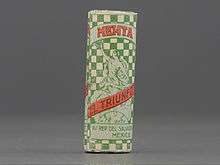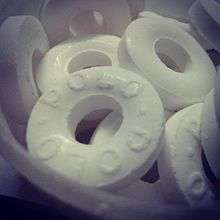Mint (candy)
|
Scotch mints | |
| Alternative names | Peppermints, spearmints |
|---|---|
| Type | Confectionery |
| Main ingredients | Mint flavoring or mint oil or other oil (such as wintergreen) |
| Variations | Hard mints, soft mints, Scotch mints, Mint Imperials |
A mint is a food item characterized by the presence of mint flavoring or real mint oil, whether it be peppermint oil, spearmint oil, another natural source such as wintergreen, or an artificial flavoring. Sweets made with natural mints are sometimes referred to as peppermints or spearmints.
Although historically consumed as any other type of candy, mints are especially popular worldwide as an after-meal refreshment, since the taste and smell of mint oil and its active components are quite strong and feel clean and cool to the mouth. This freshens the breath and soothes the stomach.[1]
Types
Hard

Hard mints are hard candies or boiled sweets flavored with mint. Examples of hard mints include starlight mints, also known as pinwheel mints, white, circular, with red or green rays emitting from the middle; candy canes; humbugs; and brand name mints such as Altoids and Ice Breakers.
In addition to breath freshening, mints that actually contain peppermint oil or extract have been popular in helping with digestion after a meal. Peppermint has muscle relaxant properties and therefore may relax the smooth muscles of the GI tract, allowing for easier passage of food contents. However, since the lower esophageal sphincter may be relaxed, peppermint may aggravate "heartburn" or GERD.
Peppermint also seems to be effective in relieving intestinal gas and indigestion.[1] According to the German Commission E Monograph, real peppermint oil or extract has been used for cramp-like complaints in the gastrointestinal tract. This can help to explain why mints with real peppermint oil, in addition to peppermint tea, have been popular for and are frequently used after meals to help with digestion as well as to help freshen the breath.
Soft
Soft mints, such as "dinner mints" and "butter mints", are soft candies, often with a higher butter content, that dissolve more readily inside one's mouth.
Scotch
A "scotch mint" or "pan drop" is a white round candy with a hard shell but fairly soft chewy middle, popular in Great Britain and other Commonwealth nations and in Europe. Scotch mints were traditionally spheroids, more recently moving toward a larger, discoid shape. The name "scotch mint" comes from the specific mint plant Mentha × gracilis. The company Perfetti Van Melle markets scotch mints in a variety of flavours as Mentos candies.
Gallery

See also
References
- 1 2 "Archived copy". Archived from the original on 2007-08-30. Retrieved 2007-09-11.
Further reading
- Blumenthal, et al. The Complete German Commission E Monographs First Edition 1998 American Botanical Council, USA.
- Grigoleit HG, Grigoleit P (August 2005). "Pharmacology and preclinical pharmacokinetics of peppermint oil". Phytomedicine. 12 (8): 612–6. doi:10.1016/j.phymed.2004.10.007. PMID 16121523.
- Baker JR, Bezance JB, Zellaby E, Aggleton JP (October 2004). "Chewing gum can produce context-dependent effects upon memory". Appetite. 43 (2): 207–10. doi:10.1016/j.appet.2004.06.004. PMID 15458807.

